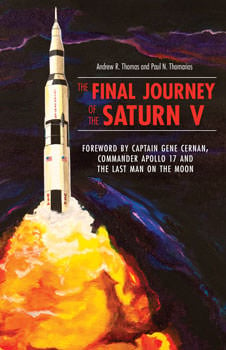Book review by David L. Hamilton
The Final Journey of the Saturn V
, by Andrew R. Thomas and Paul N. Thomarios is a good book to add to this summer's reading list. The nontechnical person should not be deterred by the title since the majority of the book covers the history of the rocket and the space race while the final chapter covers some of the details about the restoration process of the deteriorated Saturn V that weathered outside of Kennedy Space Center Florida for over a decade.
The authors do a great job explaining that during the Cold War the Soviet Union started to surpass the United States in in terms of rocketry and space exploration. For example, the Soviets launched the first satellite into Earth orbit, sent a probe to the Moon, launched the first rocket carrying a man that orbited the Earth, launched the first rocket carrying a woman that orbited the Earth and launched a rocket carrying the first man that walked in space. All these first by the Soviets had a profound effect on Americans who finally realized that if the United States was going to have an influence in space exploration, they needed to get busy. And busy they got.
After a challenge from President Kennedy to put a man on the Moon and safely return him before the end of the 1960's and a cash infusion from the United States government, NASA expanded operations that employed over 400,000 individuals who worked for NASA and its many subcontractors. The Saturn V rockets that would take over a dozen men to the moon and launch Skylab into orbit is the end result of the money, manpower and determination that drove the United States of America to take the lead in the space race after the slow start and second place status it held for several years.
Sadly, after making it to the moon several times the public grew tired of NASA and the Moon missions so funding for NASA dried up. Jobs were lost and equipment was neglected and misplaced. Locating and restoring the equipment and preserving it for future generations is covered in the last chapter.
Authors Thomas and Thomarios do a great job of keeping the book nontechnical so that the causal reader who has no science background can easily understand and enjoy it while keeping it interesting enough for the more experienced reader who specializes in the history of space flight.
A real plus for this book is an impressive foreword written by Captain Gene Cernan, Commander of Apollo 17 and the last man to have walked on the Moon. In addition to the foreword, there are many unique photographs ranging from those that made the Moon landings possible to the equipment involved and those in charge of restoring the Saturn V for our future generations.
See more information about the book at the
University of Akron Press webpage.
Reviewer David Hamilton and his wife live in Conway, Arkansas. They are amateur astronomers that love spending nights stargazing. David is an Educational Technologist and a multidisciplinary researcher currently attending the University of Arkansas at Little as a graduate student. David is an alumni of the University of Oklahoma and Rose State College.
 Universe Today
Universe Today
